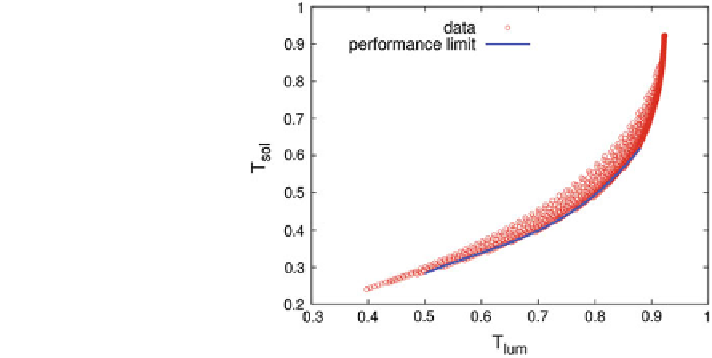Civil Engineering Reference
In-Depth Information
Fig. 20 Luminous and solar
transmittance (T
lum
and T
sol
,
respectively) for a layer
containing 1 vol. % of
dispersed spherical ITO
nanocrystals. The curve
delineates an approximate
performance limit for
plasmonic electrochromism.
From Li et al. (
2012b
)
absorptance can cover the near-infrared wavelength interval, which proves that T
sol
can be modulated, while T
lum
remains large. Figure
20
reports T
sol
as a function of
T
lum
based on a comprehensive set of computations (Li et al.
2012b
). It is found
that, for example, an optimized sample yields T
lum
= 0.60 together with
T
sol
& 0.34 in the colored state. However, it remains to be seen whether results as
good as these can be accomplished experimentally.
4 Concluding Remarks
Electrochromism has been well known for decades in a number of oxides (Deb
1973
; Granqvist
1995
), and applications have been discussed and investigated ever
since the discovery of the phenomenon. The evolution of technology based on
electrochromism has been disappointingly slow, however, and reasons for this
were mentioned above. Buildings with electrochromic glazings have been con-
sidered for many years (Baetens et al.
2010
; Jelle et al.
2012
) but have not yet
made it to the commodity market. It seems that this situation is about to change in
the near future, though, and several of the large glass manufacturers are currently
(2013) investing in production units for electrochromic glazings, and there is
concurrent development in low-cost manufacturing using roll-to-roll coating for
electrochromic foil that can be used for laminating glass as well as for building
refurbishment by retrofitting existing windows (Granqvist
2012c
). Importantly, the
roll-to-roll technology also allows new business models since it decouples the
electrochromic functionality from glass coating and window manufacturing.
Windows with variable optical properties have been something of a Holy Grail
for glass architecture for many years (Wigginton
1996
). It should be noted that
they lead to a new paradigm for buildings, which are no longer stale entities of
concrete, glass, and other building materials but dynamic units capable of regu-
lating flows of light and energy in response to dynamic needs and user preferences.

